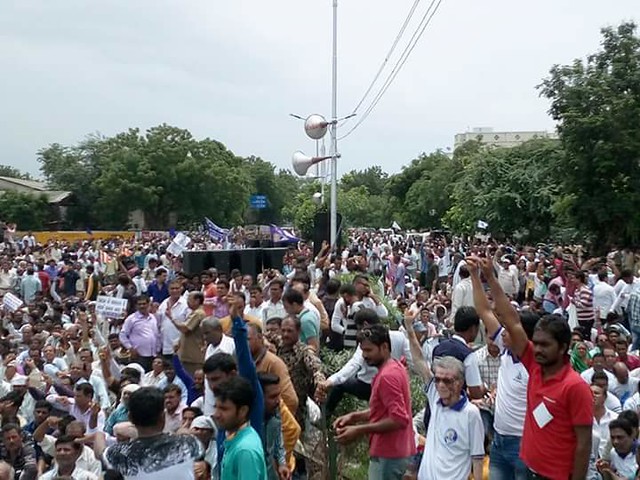By Amit Kumar, TwoCircles.net
Ahmedabad: The Azaadi Kooch (Azadi March) oragnised by Una Dalit Atyachar Ladat Samiti from August 5 to August 15, starting from Ahmedabad and ending at Una, Gujarat, entered its second day, with protesters reiterating their demands of not skinning dead cows anymore, apart from demanding compensation for the victim families.
On July 11, four Dalit workers were beaten up mercilessly by Gau Raksha Dals for skinning a dead cow, and the video of them being beaten up was circulated widely on social media. Since then, the Dalits have risen up in protest and the ongoing march, which culminates in Una on August 15, is being seen as a show of strength by the state’s Dalits who have decided that they will no more be at the receiving end of such atrocities.

The march, which started with about 500 people being flagged off by school girls, reached Dholka after the first day, where they were welcomed warmly by hundreds of people. The march will continue on to Koth. At Siddharth Educational Trust in Sonar Kui, Gujarat, the Dalits took a pledge never to dispose off dead cattle ever again. Apart from this, the other demands of the protesters include booking the culprits under Prevention of Anti-Social Acts, setting up of special courts for offences under the Atrocities Act to be set up in all 25 districts of the state, and that all city corporations in Gujarat should pay Safai Karamcharis on par with the Sixth pay commission.
According to Manjula Pradeep, Executive Director, Navsarjan Trust, these protests are the results of years of anger and frustration in the Dalits, especially the youth. “The Dalit youth have been protesting for years on the local level against the discrimination that they face, and the Una incident worked as a tipping point. In many cases, the youth have joined the protests even though the older generation remains circumspect. Caste-based discrimination has long been swept under the carpet by the state administration, but no longer,” she said.
Pradeep added that these protests were just the start of the agitation, and will challenge not just societal norms but also the poltical hierarchy in the state. “The protesters will also be working on making a political manifesto which will list all their demands, and it is up to the political parties to accept or reject the demands,” she added. Also, the Saurasthra region in Gujarat will witness a Mahapanchayat on August 31 and over 50,000 people are expected to join in.
The protests have left district administration completely helpless, and with Dalits refusing to work, there are multiple efforts being made to convince them to get back “to their jobs”, said Jayesh Solanki, a social activist working in Una. “Until now, the Savarnas (upper-castes) and the district administration could rely on Dalits to do their dirty work. But now that the Dalits have said no, the Savarnas are scared. Some upper-castes have already tried to talk to Dalits but to no avail,” he said. Solanki added that one effect of these protests has been that in areas where Dalits are in the minority, they are now being ostracised by upper-castes. “To be honest, this was expected, and we will fight against such discrimination at all possible fronts,” he added.

